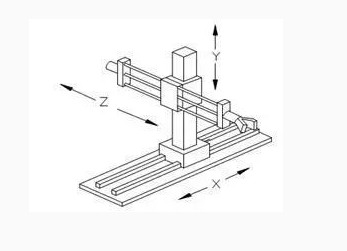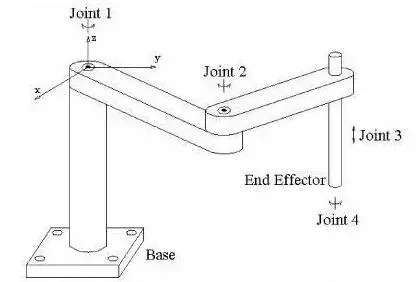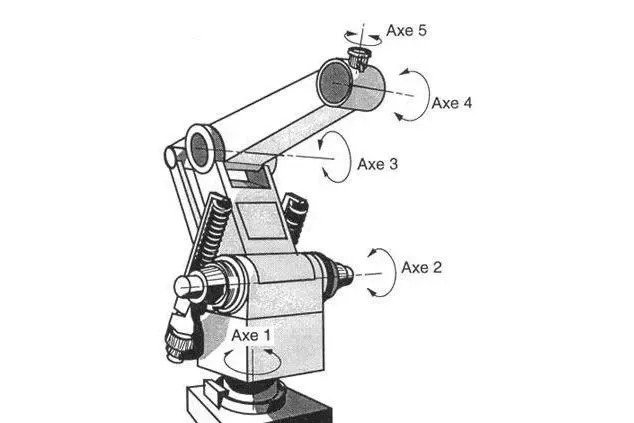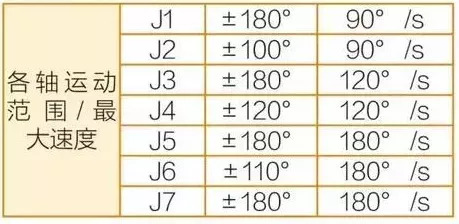In recent years, multinational robot giants have launched seven-axis industrial robots to seize new high-end markets, which has triggered our in-depth thinking about seven-axis industrial robots, what unique technical advantages it has, and what research and development difficulties exist. Which industrial seven-axis robot products have been released, and which stage has China entered into the development and industrialization of seven-axis industrial robots?
How many axes should an industrial robot have?
At present, industrial robots have been widely used in all walks of life, but we also found that industrial robots not only have different shapes, but also have different number of axes. The axis of the so-called industrial robot can be explained by the professional term degrees of freedom. If the robot has three degrees of freedom, it can move freely along the x, y, and z axes, but it cannot tilt or rotate. When the number of axes of the robot increases, it means higher flexibility for the robot. So how many axes should an industrial robot have? A three-axis robot is also called a Cartesian or Cartesian robot. Its three axes allow the robot to move in three directions. This robot is generally used for simple handling work.

A four-axis robot can rotate along the x, y, and z axes. Unlike a three-axis robot, it has a fourth axis that moves independently. Generally speaking, a SCARA robot can be considered a four-axis robot.

Five-axis is the configuration of many industrial robots. These robots can rotate through the three space circles of x, y, and z. At the same time, they can rely on the axis on the base to realize the turning action, as well as the axis that the hand can rotate flexibly, which increases its flexibility.

The six-axis robot can pass through the x, y, and z axes, and each axis can rotate independently. The biggest difference from the five-axis robot is that there is an additional axis that can rotate freely. The representative of the six-axis robot is the Universal Robot. Through the blue cover on the robot, you can clearly calculate the number of axes of the robot.
A seven-axis robot, also known as a redundant robot, has an extra axis compared to a six-axis robot, which allows the robot to avoid some specific targets, facilitates the end effector to reach a specific position, and can more flexibly adapt to some special working environments. As the number of axes increases, so does the flexibility of the robot. However, in current industrial applications, three-axis, four-axis and six-axis industrial robots are most used because, in some applications, high flexibility is not required, while three-axis and four-axis robots Axis robots are more cost-effective, and three- and four-axis robots also have great advantages in speed. In the future, in the 3C industry that requires high flexibility, the seven-axis industrial robot will have a place to be used. With its increasing precision, it will replace manual assembly of precision electronic products such as mobile phones in the near future. __Technical analysis: Where is the seven-axis industrial robot stronger than the six-axis industrial robot? __From a technical point of view, what are the problems with the six-axis industrial robot, and what is the strength of the seven-axis industrial robot? (1) Improve the kinematics characteristics In the kinematics of the robot, three problems make the motion of the robot very restricted. The first is the odd isoform. When the robot is in an odd shape, its end effector cannot move in a certain direction or exert a torque, so the odd shape greatly affects the motion planning.
The sixth axis and the fourth axis of the six-axis robot are collinear. The second is that the joint displacement exceeds the limit. In real working conditions, the angular range of motion of each joint of the robot is limited. The ideal state is plus or minus 180 degrees, but many joints cannot do it. In addition, the seven-axis robot can prevent the angular velocity from moving too fast, so that the angular velocity is distributed more evenly.

The third is the obstacle in the working environment. In the industrial environment, there are various environmental obstacles in many occasions, and the traditional six-axis robot cannot only change the posture of the end mechanism without changing the position of the end mechanism. (2) Improve the dynamic characteristics For a seven-axis robot, using its redundant degrees of freedom can not only achieve good kinematic characteristics through motion trajectory planning, but also we can use its structure to achieve the best dynamic performance. The seven-axis robot can realize the redistribution of joint torque, which involves the problem of static force balance of the robot, that is, the force acting on the end can be calculated by a certain algorithm to calculate how much force each joint bears. For a traditional six-axis robot, the force of each joint is certain, and its distribution may be unreasonable. However, for a seven-axis robot, we can adjust the torque of each joint through the control algorithm, so that the torque borne by the weak link is as small as possible, and the torque distribution of the entire robot is more uniform and more reasonable. (3) When a fault-tolerant robot fails, if one joint fails, the traditional six-axis robot cannot continue to complete the work, while the seven-axis robot can adjust the speed of the faulty joint (kinematic fault tolerance) and the torque of the faulty joint (dynamic fault tolerance). ) of the redistribution implementation continues to work correctly. __The seven-axis industrial robot products of international giants__The seven-axis industrial robot is still in the initial stage of development, both from the product point of view and from the application point of view, but major manufacturers have been pushing related products at major exhibitions. It can be imagined that its future development potential is still very optimistic. - KUKA LBR iiwa In November 2014, KUKA first released KUKA's first seven-degree-of-freedom lightweight and sensitive robot LBRiiwa at the China International Industry Fair Robot Exhibition. The LBRiiwa seven-axis robot is designed based on a human arm, and combined with an integrated sensor system, this lightweight robot has programmable sensitivity and a very high level of precision. The seven-axis LBRiiwa is equipped with high-performance collision detection functions and integrated joint torque sensors in all axes to realize human-machine collaboration.
The seven-axis design makes this product of KUKA highly flexible and can easily cross obstacles. The structure of the LBRiiwa robot is designed with aluminum materials, and its own weight is only 23.9 kg. It comes in two payloads, 7kg and 14kg, making it the first lightweight robot with a payload of more than 10kg. - ABB YuMi On April 13, 2015, ABB officially launched YuMi, the world's first two-arm industrial robot that truly realizes human-machine collaboration, to the market at the Hannover Messe in Germany.
Each single arm of YuMi has seven degrees of freedom, and the body weight is 38 kg. The load of each arm is 0.5 kg, and the repeatability of positioning can reach 0.02 mm, so it is especially suitable for small parts assembly, consumer goods, toys and other fields. From the precision parts of mechanical watches, to the processing of mobile phones, tablet computers, and desktop computer parts, YuMi is no problem, and this reflects the expanded working space, flexibility and flexibility of this redundant robot. agility, precision and other excellent characteristics. - Yaskawa Motor SIA, a well-known Japanese robot manufacturer and one of the "Four Families", also released a number of seven-axis robot products. Among them, the SIA series robots are light and agile seven-axis robots, which can provide human-like flexibility and can accelerate rapidly. The lightweight and streamlined design of this series of robots makes them ideal for installation in tight spaces. The SIA series offers high payloads (5kg to 50kg) and a large working range (559mm to 1630mm), making it ideal for assembly, injection molding, inspection, and more.
In addition to light-weight seven-axis robot products, Yaskawa also released a seven-axis robot welding system. Its high degree of freedom can maintain the most suitable posture as much as possible to achieve high-quality welding results, especially suitable for inner surface welding to achieve the best approach. Location. In addition, the product can be arranged in high density, and it is easy to avoid the interference between it and the shaft and the workpiece, showing its excellent obstacle avoidance function. - Nachi Fujikoshi PrestoMR20 As early as the end of 2007, Nachi Fujikoshi developed a seven-degree-of-freedom robot "PrestoMR20". By using a seven-axis design, the robot can perform more complex workflows and move in a narrow work area like a human arm. In addition, the torque of the front end part (wrist) of the robot has been increased to about twice that of the original conventional six-axis robot. The torque of the standard configuration is 20 kg. By setting the range of motion, it can carry objects up to 30 kg, and the working range reaches 1260 mm. , the repeatability of positioning is 0.1 mm. By adopting a seven-axis structure, the MR20 can operate from the side of the machine when picking and placing workpieces on the machine. This improves the efficiency of operations such as preparations and maintenance. The space between machines can be reduced to less than half of that of conventional six-axis robots.
In addition, Nachi Fujikoshi also released two industrial robots, MR35 (with a load of 35 kg) and MR50 (with a load of 50 kg), which can be used in applications in small spaces and places with obstacles. - OTC seven-axis industrial robot Japan's DAIHEN Group Odix launched the latest seven-axis robot (FD-B4S, FD-B4LS, FD-V6S, FD-V6LS, FD-V20S). Due to the rotation of the seventh axis, they can realize the twisting action like a human wrist and can realize welding for more than one week; in addition, the seven-axis robot (FD-B4S, FD-B4LS) hides the welding cable in the robot body, Therefore, there is no need to care about the interference between the robot and the welding fixture and the workpiece during the teaching operation, the movement is very smooth, and the degree of freedom of the welding posture has also been improved, which can make up for the traditional robot due to interference with the workpiece or the welding fixture. . - Baxter and Sawyer of RethinkRobotics RethinkRobotics are pioneers of collaborative robots. Among them, the first developed Baxter dual-arm robot has seven degrees of freedom in both arms and a single arm with a maximum working range of 1210 mm. Baxter can handle two different tasks at the same time tasks to increase applicability, or process the same task in real time to maximize output. Sawyer, launched last year, is a single-arm seven-axis robot that uses the same tandem elastic actuators for its flexible joints, but the actuators for its joints have been redesigned to make it smaller. Due to the seven-axis design and the extended working range to 100 mm, it can complete tasks with larger loads, with a payload of 4 kg, which is much larger than the Baxter robot's 2.2 kg payload.
- Yamaha seven-axis robot YA series In 2015, Yamaha launched three seven-axis robots "YA-U5F", "YA-U10F", "YA-U20F", which are all driven by the new controller "YA-C100" control. The 7-axis robot has an E-axis equivalent to a human elbow, so it can bend, twist, and stretch freely. Even in narrow gaps where robots with less than 6 axes are difficult to perform operations, operations and settings can be completed smoothly. In addition, a low squat position and movement around the back of the unit can be achieved. The hollow structure of the actuator is adopted, and the device cable and air hose are built into the robot arm, so that it does not interfere with the surrounding equipment, and a compact production line can be realized. In addition, the Taiwan Precision Machinery Research and Development Center has also developed a prototype of a dual-arm seven-axis robot, which is expected to help Taiwanese manufacturers create a production tool for 3C electronics manufacturing and narrow the technological gap between domestic and foreign. __The domestic seven-axis robot is here, can it achieve overtaking on a curve? __The research and development of China's seven-axis industrial robot began in the early 1990s. At that time, the leader of the project was Zhang Qixian, a late famous robotics expert and academician of the Chinese Academy of Engineering. One of the main contributions of Academician Zhang Qixian was to complete the seven Development of a robot prototype with redundant degrees of freedom.
In the late 1980s, Zhang Qixian, a late famous robotics expert and academician of the Chinese Academy of Engineering, was very difficult to develop. Few countries in the world have developed a seven-degree-of-freedom redundant robot prototype. After several years of hard work led by Academician Zhang Qixian, the research group completed the development of the first seven-degree-of-freedom redundant robot prototype at the end of 1993, and passed the "863" project acceptance and ministerial-level appraisal once.
A typical redundant arm Although my country has made some achievements in redundant degree of freedom robots, it mainly stays in the stage of academic papers, scientific research reports and experimental prototypes, and has not achieved real product development, which undoubtedly restricts the development of robots in my country. The pace of products to high-end industrialization. As a leading enterprise of domestic industrial robots, SIASUN took the lead in releasing the first domestic seven-axis industrial robot at the 2015 Industrial Fair. Its own weight is 29 kg, the load is 5 kg, the repeat positioning accuracy can reach 0.02 mm, and the working radius is 0.02 mm. up to 800 mm. It has functions such as quick configuration, traction teaching, visual guidance, and collision detection. It is especially suitable for flexible production lines with compact layout and high accuracy, and meets the needs of industrial operations such as precision assembly, product packaging, grinding, testing, and machine tool loading and unloading.
At present, the vast majority of industrial robot companies in my country have not yet released seven-axis industrial robot products. Some of them say they are developing related products and will have related products within the year, while some other companies have expressed concern about seven-axis industrial robot products. , but has not yet planned to design and develop related products. my country's robot industry has made great progress in the theoretical research of seven-axis industrial robots, but there is still a big gap between commercial products and foreign countries. The reasons are mainly in the following two aspects: First, the ability of independent innovation is weak. Lack of original achievements and innovative ideas of core and key technologies, the overall technology of industrial robots in my country is more than ten years behind the advanced level of foreign countries. Second, the profitability of enterprises is low, and there is a shortage of R&D funds. The lack of core component technology has led to high production costs for enterprises, and foreign manufacturers have cut prices one after another. In 2015, more than 70% of the enterprises' ontology business was in a state of loss. According to experts, there is a gap of more than ten years between the overall technology of industrial robots in my country and the advanced level of foreign countries. The emergence of domestic seven-axis industrial robots shows that our research and development in industrial robot technology is accelerating, but we should have a clear understanding that the gap is real. Research and development of next-generation technologies such as intelligence, perception, recognition, actuation and control.
Asic Antminer Machine:Bitmain Antminer E9 (2.4Gh),Bitmain Antminer E3 (190Mh),Bitmain Antminer G2
The latest ETC Ethash Miner of asic antminer machine is Bitmain Antminer E9,it has 2.4gh/s hashrate,It's very profitable
ANTMINER is the world's leading digital currency mining machine manufacturer. Its brand ANTMINER has maintained a long-term technological and market dominance in the industry, with customers covering more than 100 countries and regions. The company has subsidiaries in China, the United States, Singapore, Malaysia, Kazakhstan and other places.
Bitmain Antminer has a unique computing power efficiency ratio technology to provide the global blockchain network with outstanding computing power infrastructure and solutions. Since its establishment in 2013, ANTMINER BTC mining machine single computing power has increased by three orders of magnitude, while computing power efficiency ratio has decreased by two orders of magnitude. Bitmain's vision is to make the digital world a better place for mankind.
Asic Antminer Machine,E9 Etc Miner,E9 Eth Miner,Antminer E9 Eth Miner,antminer ETC Miner
Shenzhen YLHM Technology Co., Ltd. , https://www.ylhm-tech.com